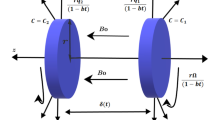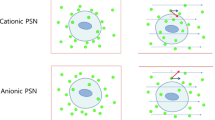Abstract
The focal target in current study is to examine the couple stress hybrid nanoparticles as a targeted drug carrier in a porous medium. The flow at stagnation point is exposed to effects of magnetic and induced magnetic fields that can be used in the field of biomedicines such as fluid motion through microcirculatory system and drug delivery system. The modelled equations are converted to dimensionless form through set of similar variables and are then solved with homotopy analysis method. In this work, it has noticed that the flow of fluid declines for augmentation in magnetic, inertial, and porosity parameters. Thermal flow increases with growth in thermophoretic, Brownian motion, radiation parameters, and with heat source, while it declines with Prandtl number and heat sink. Concentration profile increases with thermophoretic parameter and declines with growth in Brownian motion parameter and Schmidt number. Moreover, the impact of different emerging parameters upon engineering quantities of interest is determined numerically and presented in the tabular form.















Similar content being viewed by others
Abbreviations
- \(u_{w}\) :
-
Stretching velocity \(\left( {\text{m/s}} \right)\)
- u, v:
-
Velocity components along x- and y-axes \(\left( {\text{m/s}} \right)\)
- \(H_{1}\) and \(H_{2}\) :
-
Magnetic field components along x- and y-axes
- \(\eta_{0}\) :
-
Magnetic diffusivity
- \(\beta\) :
-
Magnetic field parameter
- \(\beta\) :
-
Volumetric thermal expansion coefficient
- \(\rho_{hnf}\) :
-
Density of hybrid nanofluid \(\left( {{\text{kg/m}}^{ - 3} } \right)\,\)
- \(\left( {\rho c_{p} } \right)_{hnf}\) :
-
Volumetric heat capacity of hybrid nanofluid \(\left( {{\text{m}}^{2} {\text{/s}}^{2} /K} \right)\,\)
- \(Sh\) :
-
Sherwood number
- \(\phi\) :
-
Nanoparticle volume fraction
- \(\left( {c_{p} } \right)_{s}\) :
-
Specific heat at constant pressure of nanoparticles \(\left( {{\text{m}}^{2} /{\text{s}}^{2} /K^{1} } \right)\,\)
- \(w_{1}\), \(w_{2}\) :
-
First and second nanoparticle
- \(s\) :
-
Suction or injection parameter
- \(\lambda\) :
-
Mixed convection or buoyancy parameter
- \({\text{N}}_{b}\) :
-
Brownian motion parameter
- \(\alpha\) :
-
Heat source parameter
- \(Sc\) :
-
Schmidt number
- \(\Pr\) :
-
Prandtl number
- \(T_{w}\) :
-
Surface temperature \(\left( {\text{K}} \right)\)
- \(C_{w}\) :
-
Surface concentration
- \(G_{r}\) :
-
Grashof number
- \(q_{r}\) :
-
Rosseland approximation
- \(C\) :
-
Concentration of the fluid
- \(V_{0}\) :
-
Suction/injection velocity
- \(F_{1}\) :
-
Inertia coefficient
- \(\theta \,\) :
-
Dimesionless temperature \(\left( - \right)\,\)
- \(\rho_{f}\) :
-
Density \(\left( {{\text{kg/m}}^{3} } \right)\,\)
- \(f^{\prime}\) :
-
Dimensionless velocity \(\left( - \right)\,\)
- \(\left( {\rho c} \right)_{p}\) :
-
Effective heat capacity of nanoparticles \(\left( {{\text{m}}^{2} {\text{/s}}^{2} {\text{/K}}^{1} } \right)\,\)
- \(T_{\infty } \,\) :
-
Ambient temperature \(\left( {\text{K}} \right)\)
- \(T_{0}\) :
-
Reference temperature \(\left( {\text{K}} \right)\)
- \(k\) :
-
Dimensional permeability
- \(g\) :
-
Acceleration due to gravity \(\left( {{\text{m/s}}^{2} } \right)\)
- \(\lambda_{1}\) :
-
Diffusive constant parameter
- \(Q\) :
-
Volumetric rate of heat generation/absorption
- \(\mu_{hnf}\) :
-
Viscosity of hybrid nanofluid
- \(k_{hnf}\) :
-
Thermal conductivity of hybrid nanofluid
- \(Re_{x}\) :
-
Reynolds number
- \(\rho_{s}\) :
-
Density of nanoparticles
- \(\phi_{1}\), \(\phi_{2}\) :
-
Volume fraction of first and second nanoparticles
- \(w_{f}\) :
-
Base fluid masses
- \(k_{1}\) :
-
Non-dimensional permeability parameter
- \(\Lambda\) :
-
Reciprocal magnetic Prandtl number
- \(N_{t}\) :
-
Thermophoretic parameter
- \(K\) :
-
Coupled stress parameter
- \(Nu_{x}\) :
-
Nusselt number
- \(C_{f}\) :
-
Skin friction coefficient
- \(k^{*}\) :
-
Mean absorption coefficient
- \(\mu_{e}\) :
-
Magnetic permeability
- \(l\) :
-
Characteristic length \(\left( {\text{m}} \right)\)
- \(\sigma_{1}\) :
-
Stefan-Boltzmann constant
- \(T\) :
-
Temperature of the fluid \(\left( {\text{K}} \right)\)
- \(k_{{}}\) :
-
Thermal conductivity \(\left( {{\text{Wm}}^{1} /{\text{K}}^{1} } \right)\,\,\)
- \(R\) :
-
Radiation parameter
- \(\Phi\) :
-
Dimensionless concentration \(\left( - \right)\,\)
- \(\eta\) :
-
Similarity variable
- \(\nu_{f}\) :
-
Kinematic viscosity \(\left( {{\text{m}}^{2} {\text{/s}}^{1} } \right)\,\,\)
- \(\mu_{f}\) :
-
Dynamic viscosity \(\left( {{\text{kg/m}}^{1} /{\text{s}}^{1} } \right)\,\)
References
S. Chandra, J.C. Misra, Influence of Hall current and microrotation on the boundary layer flow of an electrically conducting fluid: Application to Hemodynamics. J. Mol. Liq. 224, 818–824 (2016)
G.C. Shit, S. Majee, Magnetic field interaction with blood flow and heat transfer through diseased artery having abdominal aortic aneurysm. Eur. J. Mech. B. Fluids. 71, 1–14 (2018)
R. Ellahi, M.M. Bhatti, A.A. Khan, Influence of wall compliances on unsteady peristaltic transport of a nanofluid in a vertical rectangular duct. Wulfenia 22, 248–265 (2015)
G. Varshney, V.K. Katiyar, S. Kumar, Numerical modeling of pulsatile flow of blood through a stenosed tapered artery under periodic body acceleration. J. Mech. Med. Biol. 10(02), 251–272 (2010)
K.S. Mekheimer, Peristaltic flow of blood under effect of a magnetic field in a non-uniform channels. Appl. Math. Comput. 153(3), 763–777 (2004)
Y. Abd Elmaboud, Influence of induced magnetic field on peristaltic flow in an annulus. Commun. Nonlinear Sci. Numer. Simul. 17(2), 685–698 (2012)
P. Causin, F. Malgaroli, A mathematical and computational model of blood flow regulation in microvessels: application to the eye retina circulation. J. Mech. Med. Biol. 15(02), 1540027 (2015)
S. Dinarvand, M.N. Rostami, R. Dinarvand, I. Pop, Improvement of drug delivery micro-circulatory system with a novel pattern of CuO-Cu/blood hybrid nanofluid flow towards a porous stretching sheet. Int. J. Numer. Methods Heat Fluid Flow (2019)
A.S. Berman, Laminar flow in channels with porous walls. J. Appl. Phys. 24(9), 1232–1235 (1953)
S.W. Yuan, Further investigation of laminar flow in channels with porous walls. J. Appl. Phys. 27(3), 267–269 (1956)
M. Subhani, S. Nadeem, Numerical investigation into unsteady magnetohydrodynamics flow of micropolar hybrid nanofluid in porous medium. Phys. Scr. 94(10), 105220 (2019)
N.A. Zainal, R. Nazar, K. Naganthran, I. Pop, MHD flow and heat transfer of hybrid nanofluid over a permeable moving surface in the presence of thermal radiation. Int. J. Numer. Methods Heat Fluid Flow (2020)
M.R. Eid, M.A. Nafe, Thermal conductivity variation and heat generation effects on magneto-hybrid nanofluid flow in a porous medium with slip condition. Waves Random Complex Media. 1–25 (2020)
S.S. Ghadikolaei, K. Hosseinzadeh, M. Hatami, D.D. Ganji, MHD boundary layer analysis for micropolar dusty fluid containing Hybrid nanoparticles (Cu-Al2O3) over a porous medium. J. Mol. Liq. 268, 813–823 (2018)
N.S. Khashi’ie, N.M. Arifin, R. Nazar, E.H. Hafidzuddin, N. Wahi, I. Pop, Magnetohydrodynamics (MHD) axisymmetric flow and heat transfer of a hybrid nanofluid past a radially permeable stretching/shrinking sheet with Joule heating. Chin. J. Phys. 64, 251–263 (2020)
M. Hassan, M. Marin, A. Alsharif, R. Ellahi, Convective heat transfer flow of nanofluid in a porous medium over wavy surface. Phys. Lett. A 382(38), 2749–2753 (2018)
M. Sheikholeslami, S.A. Shehzad, CVFEM simulation for nanofluid migration in a porous medium using Darcy model. Int. J. Heat Mass Transf. 122, 1264–1271 (2018)
I. Waini, A. Ishak, I. Pop, Flow and heat transfer of a hybrid nanofluid past a permeable moving surface. Chin. J. Phys. (2020)
M.A. Guedeau-Boudeville, L. Jullien, J.M. di Meglio, Drug delivery: piercing vesicles by their adsorption onto a porous medium. Proc. Natl. Acad. Sci. 92(21), 9590–9592 (1995)
A. Narasimhan, R. Vishnampet, Effect of choroidal blood flow on transscleral retinal drug delivery using a porous medium model. Int. J. Heat Mass Transf. 55(21–22), 5665–5672 (2012)
D.Y. Arifin, L.Y. Lee, C.H. Wang, Mathematical modeling and simulation of drug release from microspheres: implications to drug delivery systems. Adv. Drug Deliv. Rev. 58(12–13), 1274–1325 (2006)
S. Dinarvand, M. Yousefi, A. Chamkha, Numerical simulation of unsteady flow toward a stretching/shrinking sheet in porous medium filled with a hybrid nanofluid. J. Appl. Comput. Mech. (2019)
C. Mircioiu, V. Voicu, V. Anuta, A. Tudose, C. Celia, D. Paolino, I. Mircioiu, Mathematical modeling of release kinetics from supramolecular drug delivery systems. Pharmaceutics 11(3), 140 (2019)
B. Bahrami, M. Hojjat-Farsangi, H. Mohammadi, E. Anvari, G. Ghalamfarsa, M. Yousefi, F. Jadidi-Niaragh, Nanoparticles and targeted drug delivery in cancer therapy. Immunol. Lett. 190, 64–83 (2017)
L. Liu, P. Miao, Y. Xu, Z. Tian, Z. Zou, G. Li, Study of Pt/TiO2 nanocomposite for cancer-cell treatment. J. Photochem. Photobiol. B. 98(3), 207–210 (2010)
Y. Gao, Y. Shi, L. Wang, S. Kong, J. Du, G. Lin, Y. Feng, Advances in mathematical models of the active targeting of tumor cells by functional nanoparticles. Comput. Methods Programs Biomed. 184, 105106 (2020)
I. Shahzadi, S. Bilal, A significant role of permeability on blood flow for hybrid nanofluid through bifurcated stenosed artery: Drug delivery application. Comput. Methods Programs Biomed. 187, 105248 (2020)
S. Ijaz, S. Nadeem, Biomedical theoretical investigation of blood mediated nanoparticles (Ag-Al2O3/blood) impact on hemodynamics of overlapped stenotic artery. J. Mol. Liq. 248, 809–821 (2017)
S.J. Liao, Explicit totally analytic approximate solution for blasius viscous flow problems. Int. J. Non-Linear Mech. 34, 759–778 (1999)
S.J. Liao, On the analytic solution of Magnetohydrodynamic flows of non-Newtonian fluids over a stretching sheet. J. Fluid Mech. 488, 189–212 (2003)
S. Dinarvand, M.N. Rostami, I. Pop, A novel hybridity model for TiO 2-CuO/water hybrid nanofluid flow over a static/moving wedge or corner. Sci. Rep. 9(1), 1–11 (2019)
S. Dinarvand, M.N. Rostami, An innovative mass-based model of aqueous zinc oxide–gold hybrid nanofluid for von Kármán’s swirling flow. J. Therm. Anal. Calorim. 138(1), 845–855 (2019)
S. Dinarvand, Nodal/saddle stagnation-point boundary layer flow of CuO–Ag/water hybrid nanofluid: a novel hybridity model. Microsyst. Technol. 25(7), 2609–2623 (2019)
M.N. Rostami, S. Dinarvand, I. Pop, Dual solutions for mixed convective stagnation-point flow of an aqueous silica–alumina hybrid nanofluid. Chin. J. Phys. 56(5), 2465–2478 (2018)
M. Yousefi, S. Dinarvand, M.E. Yazdi, I. Pop, Stagnation-point flow of an aqueous titania-copper hybrid nanofluid toward a wavy cylinder. Int. J. Numer. Methods Heat Fluid Flow (2018)
L.S. Sundar, K.V. Sharma, M.K. Singh, A.C.M. Sousa, Hybrid nanofluids preparation, thermal properties, heat transfer and friction factor—a review. Renew. Sustain. Energy Rev. 68, 185–198 (2017)
I. Shahzadi, N. Kousar, Hybrid mediated blood flow investigation for atherosclerotic bifurcated lesions with slip, convective and compliant wall impacts. Comput. Methods Programs Biomed. 179, 104980 (2019)
M. Sheikholeslami, S.A. Shehzad, Numerical analysis of Fe3O4–H2O nanofluid flow in permeable media under the effect of external magnetic source. Int. J. Heat Mass Transf. 118, 182–192 (2018)
L.S. Sundar, K.V. Sharma, M.K. Singh, A.C.M. Sousa, Hybrid nanofluids preparation, thermal properties, heat transfer and friction factor–a review. Renew. Sustain. Energy Rev. 68, 185–198 (2017)
B. Wei, C. Zou, X. Yuan, X. Li, Thermo-physical property evaluation of diathermic oil based hybrid nanofluids for heat transfer applications. Int. J. Heat Mass Transf. 107, 281–287 (2017)
Author information
Authors and Affiliations
Corresponding author
Ethics declarations
Competing Interest
The authors declare no competing interests.
Additional information
Publisher's Note
Springer Nature remains neutral with regard to jurisdictional claims in published maps and institutional affiliations.
Rights and permissions
About this article
Cite this article
Jawad, M., Khan, A. & Shah, S.A.A. Examination of Couple Stress Hybrid Nanoparticles (CuO-Cu/Blood) as a Targeted Drug Carrier with Magnetic Effects Through Porous Sheet. Braz J Phys 51, 1096–1107 (2021). https://doi.org/10.1007/s13538-021-00930-7
Received:
Accepted:
Published:
Issue Date:
DOI: https://doi.org/10.1007/s13538-021-00930-7




